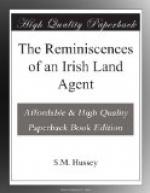Out of Mr. Finlay Dun’s book, from which I have previously quoted, I condense the following from the chapter he devoted to the estates for which I was agent.
He observes that in 1881 my firm had the supervision of eighty-eight estates, upwards of three thousand farming tenants, and annually collected rents to the value of a quarter of a million sterling. From the particulars I furnished him he deduces:—
’So recently as the end of November the Lady Day rents had been well paid up; old arrears had been reduced; on two estates in the Court of Chancery L6000 had been collected with only a few shillings in default. Dairy farmers prospering had been particularly well able to pay rents and other claims. More recent rent collections, unfortunately, were not so satisfactory. Tenants generally had earned the money, but had not been allowed to pay it over.
’Many of the low-rented estates were badly farmed and the tenantry in low water. On the higher rented, the struggle for existence had brought out extra industry and energy and led to fair success.’
The following provided an apt illustration:—
’Mr. Gould Adams of Kilmachill had a small estate on the north side of a hill rented at 20s. an acre; the rents were paid up, the tenants doing well. On the southern aspect of the same hill, with better land, at the devoutly desiderated Griffith’s valuation, which was 16s. 4d., the tenants were invariably hard up, some of them two years in arrears. All tenants had free sale, averaging five years’ rent.
’The larger proprietors, as a rule, were most helpful and liberal to their tenants. Where improvements were not effected or initiated by the landlords, they were seldom done at all. There had often been considerable difficulty in overcoming the prejudice and “the rest-and-be-thankful” spirit both of landlords and tenants.
’On Sir George Colthurst’s Ballyvourney estate, twenty miles east of Killarney, under Mr. Hussey’s auspices about L30,000 had been expended in draining, building, and roadmaking. The economic value of many holdings had been doubled, although the rents had only been increased five per cent., and subsequently the Commissioners fixed the rents at 25 per cent. less than they had been fifty years earlier.
’The extending village of Mill Street had been in great measure reconstructed by his exertions.
’The Land League having enforced non-payment of rent, the obligation to meet other debts was weakened. Although there was more money than usual in the hands of the farming community, shopkeepers were not so willingly and promptly paid as formerly. Want of security checked the improved business which should have set in after a good harvest. The Land League agitation generally originated with the publicans, small shopkeepers, and bankrupt farmers, rather than with the actual land occupiers. For peace and protection, many pay their subscription to the League and allow their names to be enrolled. The intimidation and ‘boycotting,’ which was so widely had recourse to, rendered it dangerous for either farmers or tradesmen to make a stand against the mob. With Sam Weller it was regarded expedient to shout with the biggest crowd.’




